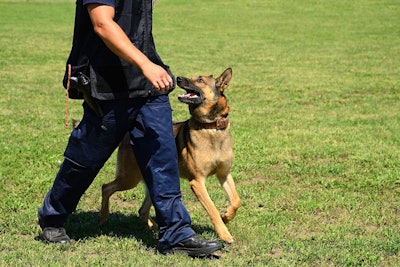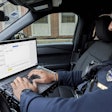 The key to keeping police dogs safe from heat stress is the handler's ability to spot a change in behavior.Canva
The key to keeping police dogs safe from heat stress is the handler's ability to spot a change in behavior.Canva
In the relentless heat of summer and even early fall in some parts of the country, officers face the important task of protecting their K-9 partners while working in sweltering temperatures. The key to keeping them safe is the handler’s knowledge of his or her dog and the ability to know when the dog’s body temperature is elevating above normal levels. Recognizing changes in a dog’s behavior is the key.
Janice Baker, DVM, owner and founder of Veterinary Tactical Group, points out that for many years when veterinarians or others would write handbooks and guidelines for canine officers, the information was focused on signs related to “after” the dog was in distress. Typically, she explains, instructions would say to watch for signs of heat stroke or heat injury such as a dog having seizures, collapsing, or maybe having bloody diarrhea.
“Well, if that's happened, that's like saying, ‘Here are the signs of a gunshot wound, or here are the signs of when everything goes bad,’” she says.
Now there is a different approach.
“Your goal is to keep it from going bad in the first place,” Baker explains. “We did a study, a review of all of the literature, and looked at it in an evidence-based way in 2011. And that's when it sort of hit us. My team that I was working with said we've got it all wrong, we shouldn't be looking at the signs that it's already happened,” says Baker.
Prevention
For a long time, a dog’s body temperature was used as a measure of if it was having trouble handling the heat. But Baker points out how now it is known that a dog’s temperature may not necessarily be a good indicator. Some really fit dogs, such as some Malinois, may reach a body temperature of 108 degrees while working, yet for a long time 106 degrees had been considered deadly. She points out that nobody ever took the temperatures of healthy dogs while working, only ones that had encountered medical problems.
“So, what we say now is look for the behavioral signs of heat injury,” she says. “My team kind of came up with this idea about 10 years ago, but everybody that was on board with it all said ‘Yes, that's what I've been thinking too,’” Baker explains.
Behavioral Signs
The United States Police Canine Association (USPCA) each year distributes an article prepared by Paul McNamara, DVM, DACVS, national veterinary medical director for the association, to raise awareness that handlers need to look for behavioral signs before dogs reach the point where they are in distress.
“Commonly seen signs of an impending problem include uncontrollable panting, an atypical disregard to basic commands, shade seeking, and laying down. More serious signs include staggering, bloody diarrhea, a non-responsive state, and seizures. If an animal is exhibiting these signs, especially the latter ones, immediate, aggressive measures must be initiated,” wrote McNamara.
Just as shared by McNamara, Baker points out there are behavioral signs that are indicators a working dog is struggling with the heat.
Refusing to return to the handler, refusing to return a ball or reward object to the handler, or even circling several times before returning to a handler all can be what Baker calls subtle signs. They may even circle around and seek shelter in the shade of a handler. All can be indicators of impending problems.
She compares it to a soldier, or police cadet at the academy, on a long run looking for any way to find brief respite, any excuse such as stopping to tie his or her shoe just to get a break to catch their breath.
“We think that the dogs are just being disobedient,” she says. “But really what they're saying is ‘Look human. I'm a Malinois, or I'm a Shepherd, whatever dog I am, I have to chase that ball if you throw it. If a guy shows up with a sleeve, or a bad guy shows up, I have to go bite him, I can't not. So, stop making me do it because I'm going to die.’”
Thermal Stress
In physics, Baker explains, thermal stress means heat stress of metals, rocks, or other objects. But in dogs, thermal stress just means the normal heating up of the body as it works harder during exercise. It’s normal for a dog to heat up because of their muscular exertion, she says.
According to Baker, a dog's primary means of cooling once they get over about 103 degrees is panting. However, eventually, the increasing body temperature can be too much for the panting to overcome. That, she says, is when heat injury can occur.
“I think the first sign we see is sort of those subtle signs of the dog, early signs, like the dog slowing down. They’re not doing the task with as much intensity. The dog will run out on the bite or run out on the problem, is chasing the ball, or whatever task you're asking them to do. They'll run out with intensity, but they'll come back slower,” Baker explains.
Those are the early signs, but more ominous and apparent signs like MacNamara detailed can follow. At this point, a key indicator is if a dog is panting uncontrollably.
“He's panting, he's slobbering all over the place. The tongue is a muscle, and it will fatigue eventually, just like a muscle in the body. And that's when we start seeing it sloppy, curly, flopping off to the side. Now, some dogs are just dorks with their tongue, and it flops all the time, you just have to know that about your dog,” Baker says.
If a handler shows a dog a toy or reward and the canine cannot close its mouth and stare back because of uncontrollable panting, that might be a sign of heat problems. They will keep panting, and maybe even be disinterested or look away. That also may be an indication of a problem.
“That's a sign two things are happening. One, their body reflexes have taken over. And even if they wanted to snap their mouth shut, or grab a hold of the sleeve or the toy, or whatever, they can't because they have to pant. If they went unconscious, they would still pant because, by that time, it's a reflex,” Baker says.
“And the other thing is that they have decided ‘I'm done with this game. I don't want to play; I don't want to die. I'm not even going to look at you when you show me that reward; I've checked out of this game.’”
She says there are no official studies that reveal this behavior; it is her conclusion drawn from many years of talking to canine trainers and observing working dogs, both in the military and law enforcement arenas.
Intermittent Cooling
When the panting is uncontrollable and the dog loses focus, it is time to stop and get it cooled down immediately. She says the consensus for many years is that when a dog reaches this point, it is time to cool it down, and not let it return to work.
But now, she says, that is not the case. Once a dog’s temperature returns to normal, it will be ready to continue.
“Cool the dog down to where he's not doing that uncontrolled panting anymore. Let him rest for a couple of minutes, and he's ready to go again. And when those signs start to get up there again, the uncontrolled panting and that avoidance behavior, stop him and cool him down again,” she says.
How do you rapidly cool a police canine after the exertion and heating of a task?
Baker says that air conditioning, in a building or a car, is not enough. They need water or something cool and wet put on their body to lower their temperature.
Medical Help, When?
Baker relates a dog in heat distress to a human hemorrhaging blood. In the case of the latter, the focus is to stop the bleeding and then transport the patient to a medical facility. The same is true with canines in that a handler should cool the dog, then seek veterinarian help – in that order.
“The first thing they need to do is cool the dog down in place. What we don't want them to do is throwing the dog into a vehicle and then driving 15 minutes, 20 minutes. That’s 15 or 20 minutes that that dog is still cooking,” Baker explains. “First cool, then transport.”
She says for years there was a myth that you should not use cold water or ice water to cool a dog in heat distress. Now, experts say that is not so.
Find anything wet and colder than the dog and put it on the dog. That could be a bottle of water an officer has on hand in a patrol vehicle, or it may be using water from a nearby natural body of water or stream to cool the dog.
She also suggests that handlers stop cooling the dog when its temperature reaches about 104 degrees but points out that many officers will not have a thermometer on hand. Since the dog has lost its ability to thermos-regulate, it will only continue to get colder once its body temperature has returned to a normal range.
Once a dog’s temperature is down to the normal range, 103 to 104, a handler should see it respond if it is not critically injured. The dog may start to wake and stand up or start to act a little more normal.
“If they are critically injured, that's when we start to see minor improvements, like if they are unconscious, then we'll start to see them blinking their eyes, maybe and flicking their ears,” she says.
Baker suggests when the dog is cooled for five minutes and shows no significant response, it is time to get to a vet, who will have additional life-saving treatments. However, she again stresses the first thing a vet will do is cool the dog, so an officer should always do that before transporting.
“If they collapse, or they want to lay down for example, if it takes them a long time to come around, if they're staggering at all, if they just seem out of it, then absolutely take them to the vet even if they seem to get better because there are some simple blood tests the vet can do to see if critical physiological the harm from heat injury has occurred, and mainly has to do with the ability for blood clotting,” Baker adds.
Handler Focus
So, it is incumbent upon the handler to stay in tune with his or her dog’s behavior, regardless of the operational situation.
Baker provides an example of just how hard it can be for a handler to focus on the dog and not on the task. Once, she was working with special forces and watching the training of new canine handlers. During a training scenario, both she and the handler trainer with her, noticed one trainee.
A team, including a prospective handler and his canine, was stacked on a door to make entry at a shoot house. The dog was jumping, lunging, and ready to go, recalls Baker. The potential handler trainee held the dog back but was fixated on the team leader and waited eagerly for the “dog up” command.
“After they did it two or three times, the dog started to get hot. We saw the dog sort of scooting around the back of the handler and laying down on the other side,” she recalls.
The handler had the dog attached to a lanyard on his belt but wasn’t looking at the dog. Again, he was too focused on the team leader.
“And the trainer pointed out to me ‘Watch that handler, he's so focused on the task, he's not looking at the dog,’” says Baker.
The dog had lost its eagerness, was no longer jumping or lunging, and was trying to find shade and lay down. The trainer stepped in, had a teaching moment with the handler trainee, and then took the dog offline and cooled him down. After that, the dog returned to the training.
“So, imagine that in an operational setting —that target focus, so to speak, might be even more so if there's true threat out there that could harm the handler or their colleagues,” Baker points out.
So, ultimately keeping a working canine safe in the heat comes down to a handler’s focus on his or her dog and watching for warning signs of heat stress.
“While the signs of heat stroke are varied and can differ from dog to dog, if you think your partner is overheated, treat him/her as such. You are probably the person best able to determine how your partner is feeling and if there is doubt, err on the side of caution,” wrote McNamara.
















